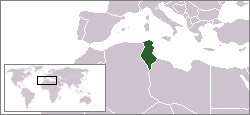
Tunisian wine has a long history dating back to the Antiquity like most Mediterranean countries with the Phoenicians and Carthage .
Contents
The agronomist Mago that lived in the city of Carthage, wrote a treaty about agronomy and viticulture, from which its techniques are still used until this day. Despite the arrival of a Muslim power since the 7th century AD, viticulture and wine production never quite disappeared from Tunisia. [1] [2]
Rosé wine accounts for a large proportion of the Tunisian production. [3]






